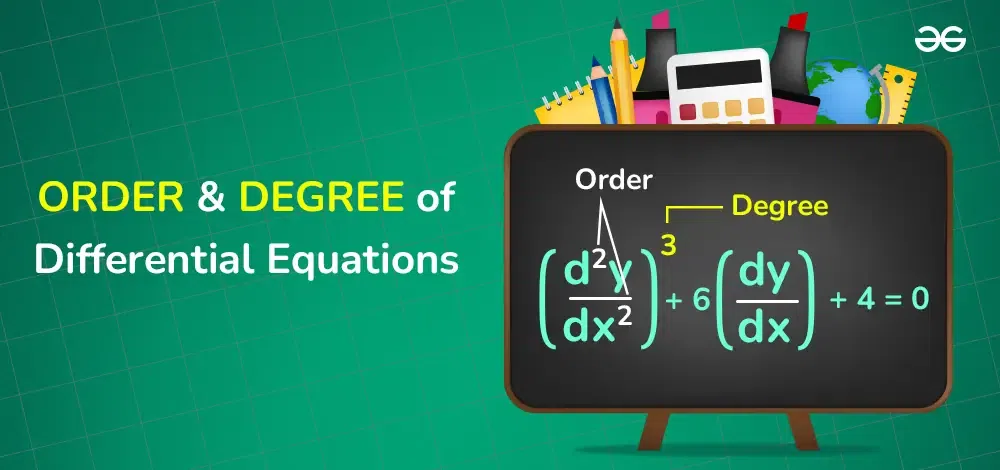
|
|
Order and Degree of differential equations indicate the degree of complexity and the number of independent variables in the differential equations. The highest derivative sets the order of the equation and offers important information about the function’s behaviour and evolution. It is an important tool for dealing with scientific and engineering problems, with applications in physics, engineering, biology, and economics. Understanding the order and degree of differential equations allows us to foresee how the function will react to changes in independent variables, allowing us to better comprehend complex systems and real-world occurrences. This inquiry delves into the significance and applications of the “Order and Degree of Differential Equations,” helping us to better comprehend the intricacies of our surroundings. 
Table of Content
What are Differential Equations?A differential equation is a mathematical formula that combines a function and its derivatives. The functions in real-world applications indicate physical quantities, and their derivatives show the rate at which those physical values change in relation to their independent variables. The general form of a differential equation is:
Learn more: Order of Differential EquationThe highest order of the derivative of the unknown function ‘y’ in a differential equation is referred to as the order of the equation. In other words, it is the power to which the equation’s highest derivative is raised in any given differential equation. Example: Determine the order of Differential Equation – d3y/dx3 + 3x(dy/dx) = ey . Answer:
First Order Differential EquationAn equation involving the first derivative of an indeterminate function is known as a first-order differential equation. It can be expressed in the following general form:
Types of First-Order Differential EquationsThere are various types of first-order differential equations, some of these are:
Second Order of Differential EquationA second-order differential equation involves the second derivative of a function that is undetermined. It has the following representation:
Types of Second-Order Differential EquationsThere are various types of second-order differential equations, some of these types are:
Degree of Differential EquationThe highest derivative of an equation, taking consideration of any coefficients or constants as well, is defined as the degree of the differential equation. It is the derivative in the equation with the highest power, in other words. When working with differential equations of the polynomial kind, determining a differential equation’s degree is important.
Speacial Case: Degree not DefinedMost of the time we can arrange the given differential equation in the form of polynomial where exponent is the order of differentiation, but for some differential equation this can be done. Those differential equations degree is not defined. In other words, degree of a differential equation can only be defined if and only if the polynomial function of derivatives can be generated from the differential equation. For example, sin(d2y/dx2) + dy/dx=0 is not a polynomial equation in derivatives because of the sine function. Therefore, its degree is not defined. Some other examples of differential equation, where degree is not defined are:
How To Find Order and Degree Of Differential Equation?To find the order and degree of Differential Equation, we can use the following steps:
Let’s consider an example for better understanding. Example: Find the order and degree of the following differential equation. 3(d2y/dx2)2 – 3 = 4xdy/dx Answer:
Read More, Examples of Order and Degree of Differential EquationLet’s look at a few examples to better understand the order and degree of differential equations: Example 1: dy/dx + 2x = 0 Answer:
Example 2: d2y/dx2 – 3(dy/dx)2+ 2x = 0 Answer:
Example 3: x2(d3y/dx3) + y3(dy/dx) = 0 Answer:
Solved Problems on Order and Degree of Differential EquationProblem 1: What is the order (if defined) and degree of the differential equation: d4y/dx4 + (d2y/dx2)2 – 3(dy/dx) + y = 9? Solution:
Problem 2: Determine the order (if defined) and degree of the differential equation: [d2y/dx2 + (dy/dx)2]4 = k2(d3y/dx3)2. Solution:
Problem 3: Find the order (if defined) of the differential equation: √(d2y/dx2) + dy/dx = x. Solution:
Problem 4: What is the order (if defined) and degree of the differential equation: dy/dx + (x2 + 5)y = x5? Solution:
Practice Problems on Order and Degree of Differential EquationProblem: Find Order and Degree of following differential equations:
SummaryDifferential equations are mathematical equations that involve functions and their derivatives. These equations describe the relationship between a function and its rates of change, capturing how quantities evolve over time or space. Differential equations are classified into two main types: ordinary differential equations (ODEs), which involve functions of a single variable and their derivatives, and partial differential equations (PDEs), which involve functions of multiple variables and their partial derivatives. Solving differential equations is fundamental in various scientific and engineering disciplines, as they model a wide range of phenomena, from the motion of objects and electrical circuits to population dynamics and heat distribution. The solutions to differential equations can be explicit, providing a direct formula for the unknown function, or implicit, expressed as a relationship between the function and its derivatives. Techniques for solving differential equations include separation of variables, integrating factors, and numerical methods. Understanding differential equations is essential for analyzing and predicting the behavior of dynamic systems. FAQs on Order and Degree of Differential EquationDefine the Order of a Differential Equation.
What does a Differential Equation’s Order Represent?
How is the Order of a Differential Equation Determined?
What is the Difference between a First-Order and a Second-Order Differential Equation?
Can a Differential Equation change its Order?
What are Some Examples of First-Order Differential Equations?
What is the Difference between Degree and Order of a Differential Equation?
|
Reffered: https://www.geeksforgeeks.org
| Class 12 |
Type: | Geek |
Category: | Coding |
Sub Category: | Tutorial |
Uploaded by: | Admin |
Views: | 12 |